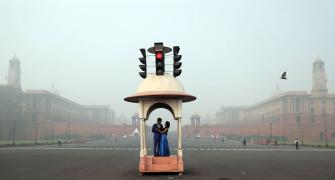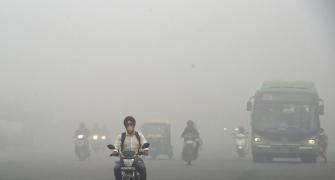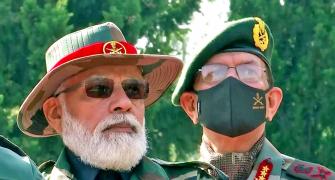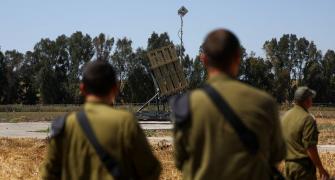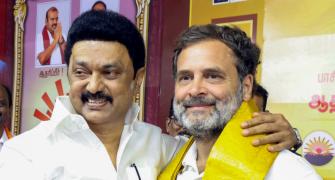A thick layer of acrid smog hung over Delhi-National Capital Region on Friday after residents flouted the firecracker ban and emissions from farm fires in the region peaked at 36 per cent, pushing the capital's 24-hour average air quality index for the day after Diwali to 462, the highest in five years.

In neighbouring Noida, the 24-hour AQI was 475, the highest in the country.
The neighbouring cities of Faridabad (469), Greater Noida (464), Ghaziabad (470), Gurgaon (472) also recorded 'severe' air pollution levels.
As smog partially blotted out the sun in Delhi and residents complained of itchy throat and watery eyes, the city's Environment Minister Gopal Rai accused the BJP of instigating people to burn crackers by linking it to religion.
Ahead of the festive season, the Delhi government had announced a complete ban on firecrackers till January 1, 2022, and ran a campaign against their sale and use.
The air quality across Delhi-NCR nosedived to the 'severe' zone on Diwali night and even the recently-launched smog tower at Connaught Place could not provide breathable air to residents nearby, government data showed.
Around 9 pm on Thursday, the 24-metre-high air purifier, considered the first such structure in India, recorded a PM2.5 concentration of 642 micrograms per cubic metre at the inlet and 453 micrograms per cubic metre at the outlet.
The smog tower could only reduce the PM10 level from 649 micrograms per cubic meter to 511 micrograms per cubic meter, according to the readings taken at 9 pm on Thursday.
On Diwali night, the PM10 levels at Dwarka-Sector 8, Punjabi Bagh, Wazirpur, Ashok Vihar, Anand Vihar and Jahangirpuri ranged between 800 micrograms per cubic metre and 1,100 micrograms per cubic metre, DPCC data showed.
PM2.5 levels at Vivek Vihar, Okhla-Phase II, Wazirpur, Ashok Vihar, Anand Vihar and Jahangirpuri ranged between 600 micrograms per cubic metre and 1000 micrograms per cubic metre.
Delhi's 24-hour average AQI, which entered the 'severe' zone on Thursday night, stood at 462 at 4 pm on Friday.
According to the Central Pollution Control Board (CPCB), the 24-hour average AQI for the day after Diwali was 435 last year, 368 in 2019; 390 in 2018; 403 in 2017 and 445 in 2016.
The AQI was 382 on Diwali day this year, 414 in 2020; 337 in 2019; 281 in 2018; 319 in 2017 and 431 in 2016.
The 24-hour average concentration of lung-damaging fine particles known as PM2.5 in Delhi-NCR shot up from 243 micrograms per cubic metre at 6 pm on Thursday to 430 micrograms per cubic metre at 2 pm on Friday, around seven times the safe limit of 60 micrograms per cubic metre.
The PM10 levels crossed the 500 micrograms per cubic metre mark around 5 am on Friday and stood at 558 micrograms per cubic metre at 2 pm.
According to the Graded Response Action Plan, the air quality is considered to be in the 'emergency' category if PM2.5 and PM10 levels continue to be above 300 micrograms per cubic metre and 500 micrograms per cubic metre respectively for 48 hours or more.
Low temperature and fog in the morning allowed the accumulation of pollutants.
Fog conditions intensified in Delhi-NCR on Friday morning, lowering visibility at the Indira Gandhi International Airport and the Safdarjung Airport to the range of 200 to 500 metres at 5.30 am.
Visibility in parts of the city dropped to 200 metres, said R K Jenamani, a senior scientist at the India Meteorological Department.
People from a large number of areas in the national capital had reported rampant cracker bursting on Thursday night. Cracker bursting continued till late night in NCR cities of Noida, Faridabad and Gurgaon.
Delhi Environment Minister Rai, who deployed 20 anti-smog guns to combat high pollution levels, alleged the BJP instigated people to burn crackers for political gains.
"A large number of people did not burst firecrackers. I thank them all. But some people burst firecrackers on purpose. The BJP made them do it," he said.
Concerned citizens and environmental activists shared pictures and videos of people bursting firecrackers on social media and termed the government ban a 'joke'.
The Haryana government had imposed a ban on the sale or use of all kinds of firecrackers in 14 of its districts in the NCR.
The Uttar Pradesh government had allowed the use of green crackers on Diwali only for two hours in areas with moderate or better air quality.
Stubble burning accounted for 36 per cent of Delhi's PM2.5 pollution on Friday, the highest this season so far, according to government air quality forecast agency SAFAR.
"The overall air quality of Delhi plunged to the upper end of the 'severe' category with additional firework emissions... The share of stubble emissions has peaked today at 36 per cent," said Gufran Beig, founder-project director of SAFAR.
"Local winds have picked up and fast dispersion (of pollutants) is expected now. Without any more firecracker emissions, the AQI will improve to the 'very poor' category by tonight, although the stubble contribution is expected to remain almost the same (on Saturday)," he said.
On Thursday, farm fires accounted for 25 per cent of Delhi's PM2.5 pollution.
Last year, the share of stubble burning in Delhi's pollution had peaked at 42 per cent on November 5.
In 2019, crop residue burning accounted for 44 per cent of Delhi's PM2.5 pollution on November 1.
The concentration of stubble burning in Delhi's PM2.5 pollution was 32 per cent on Diwali last year as compared to 19 per cent in 2019.

